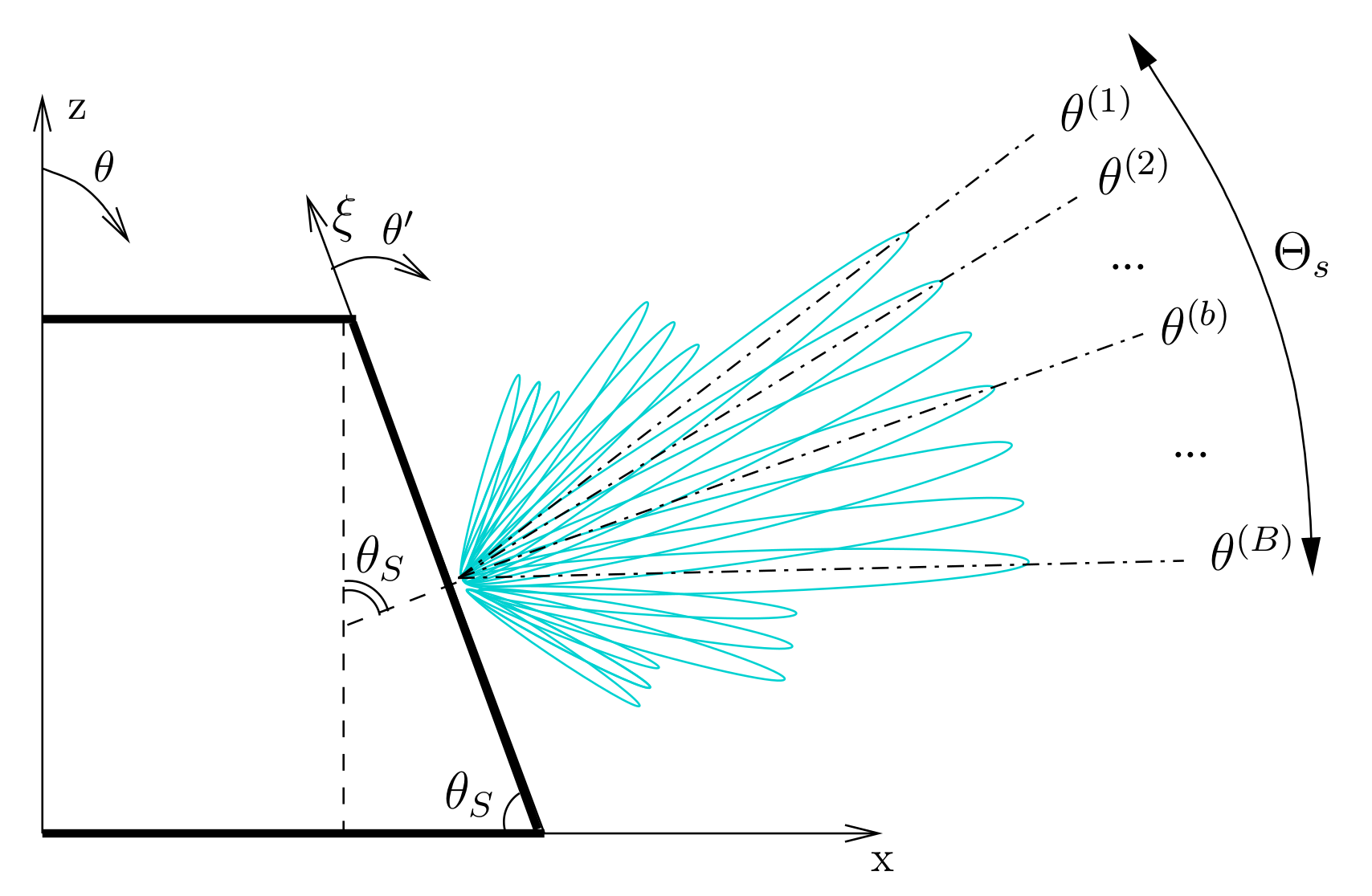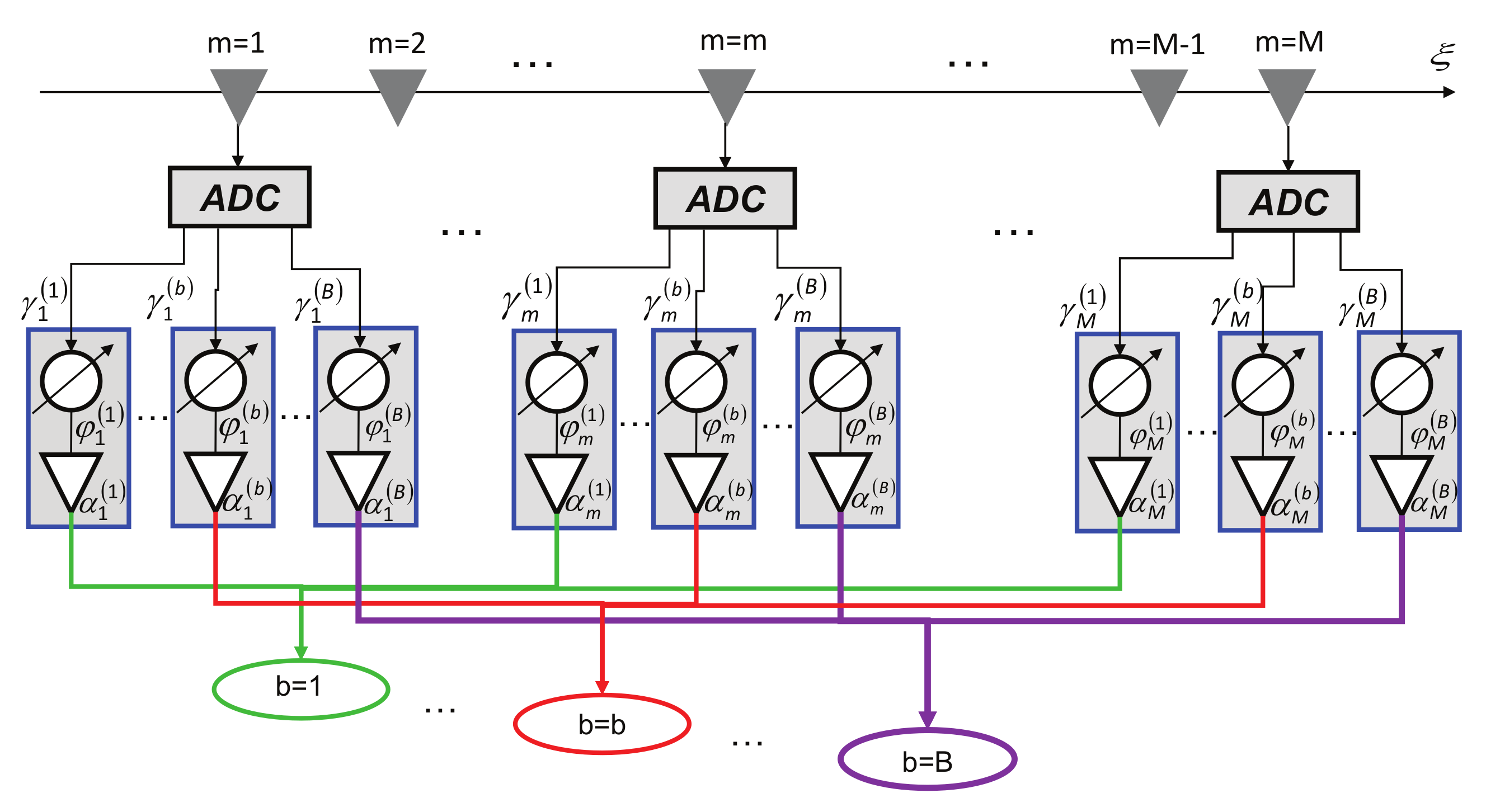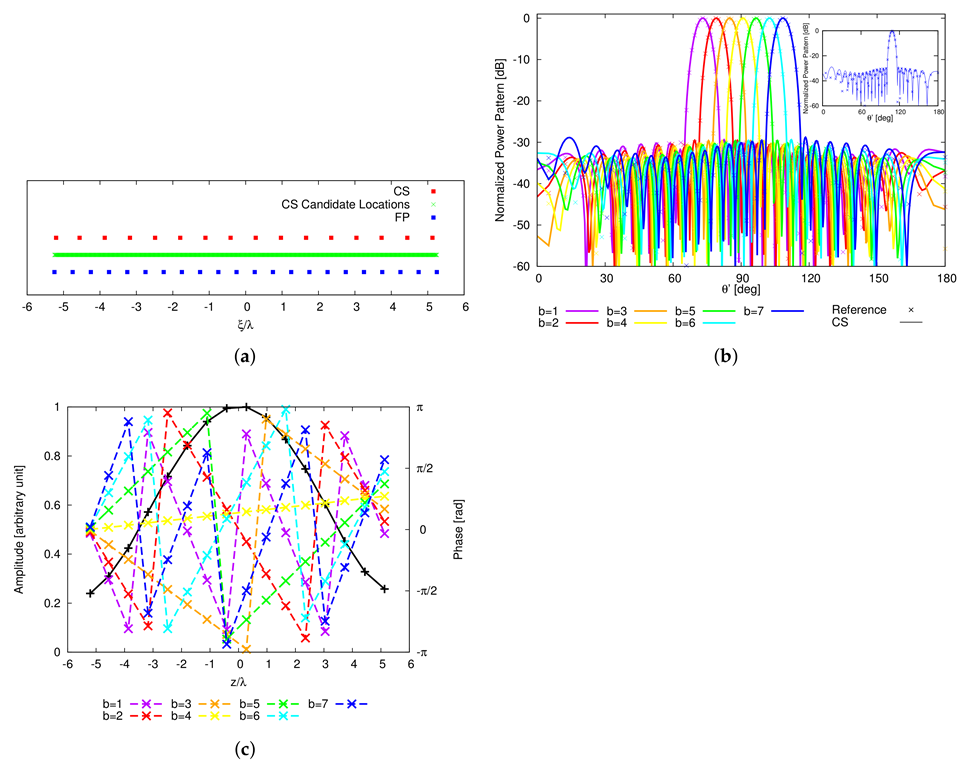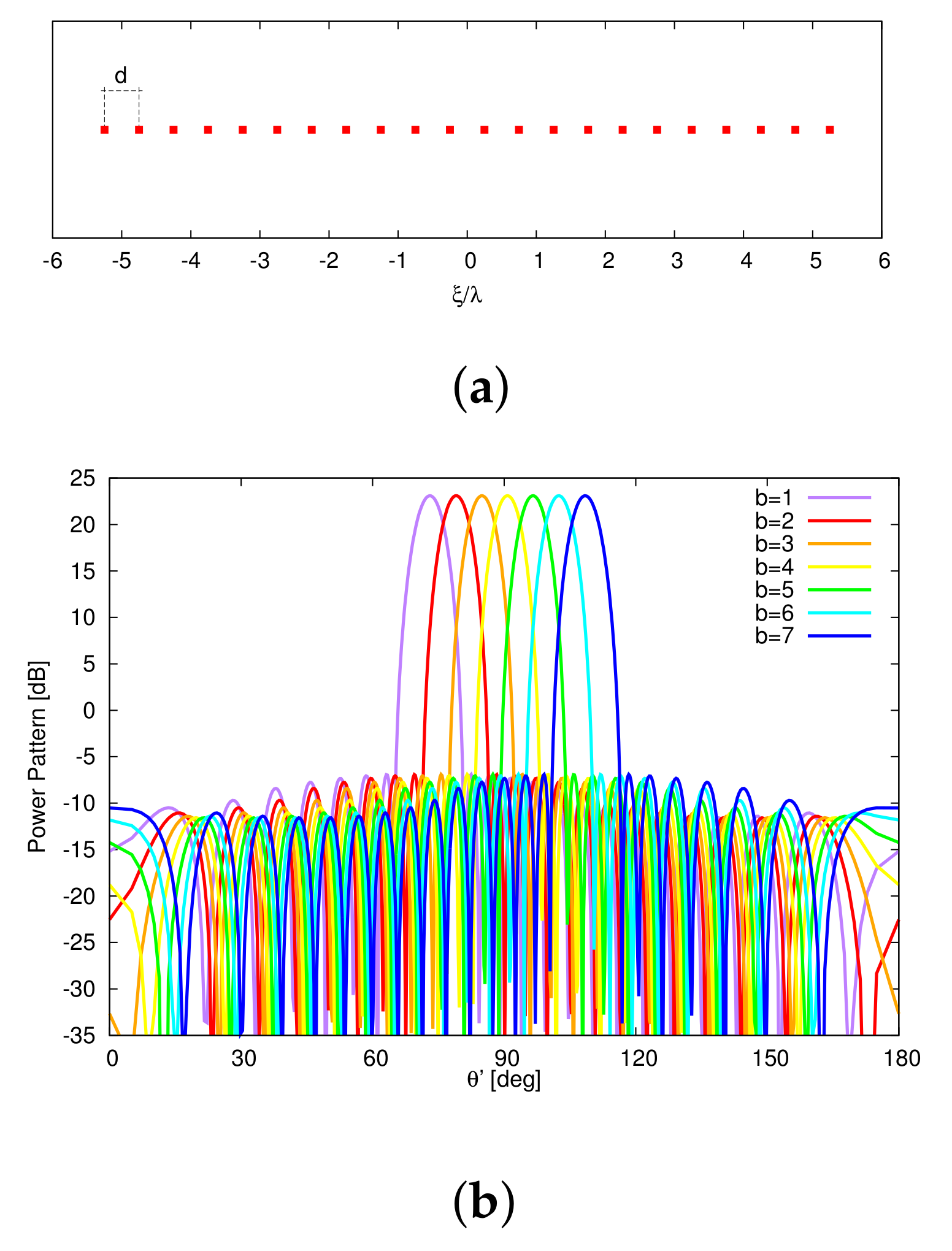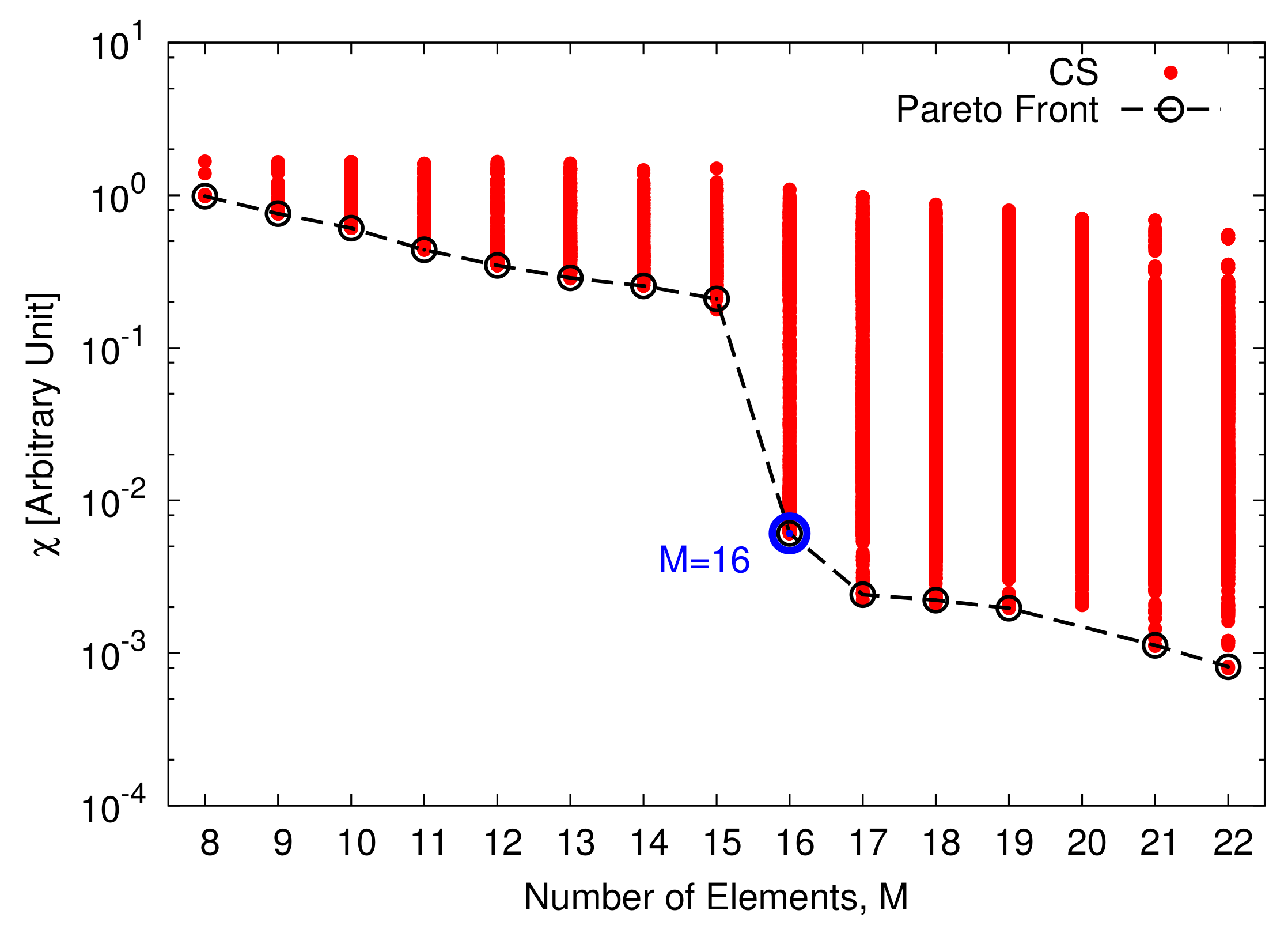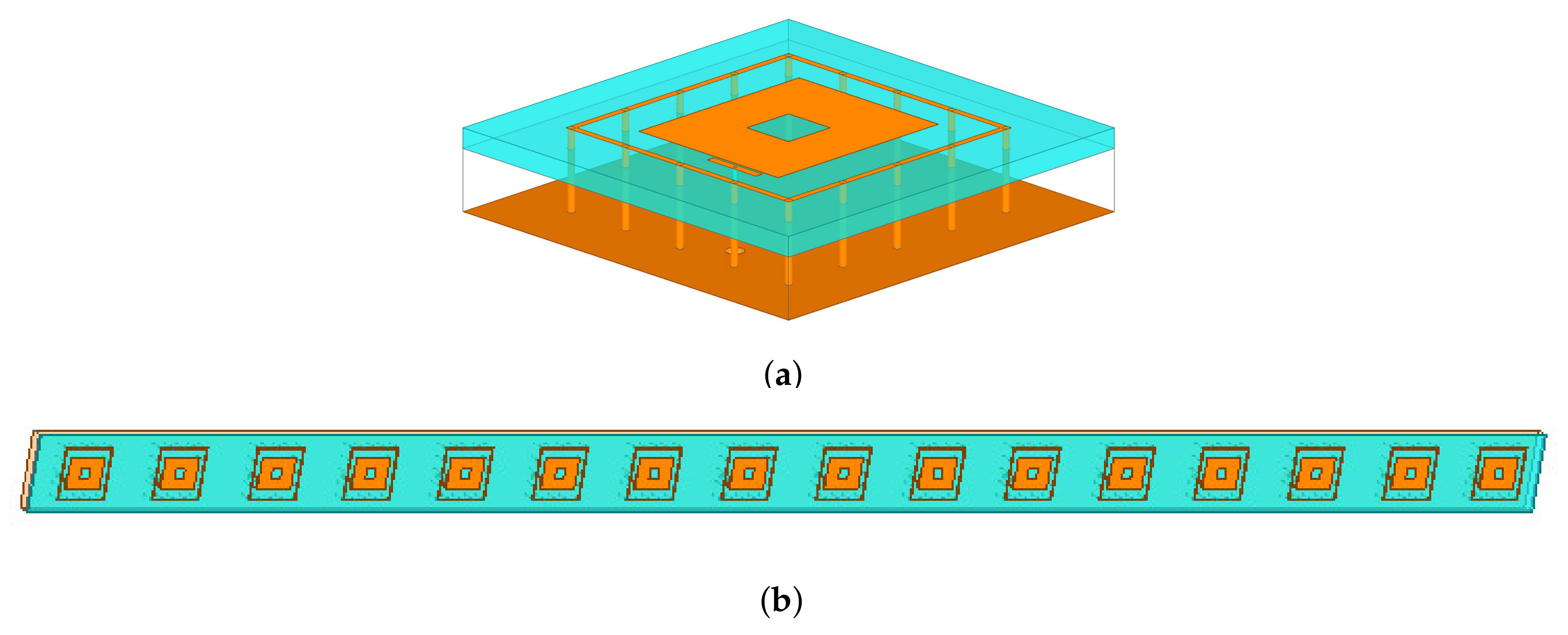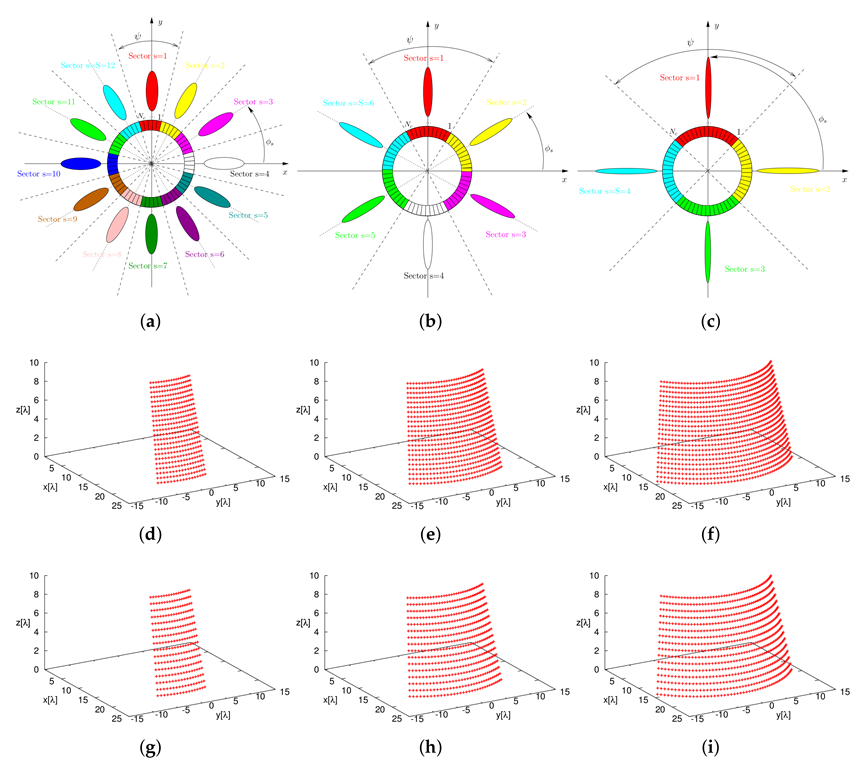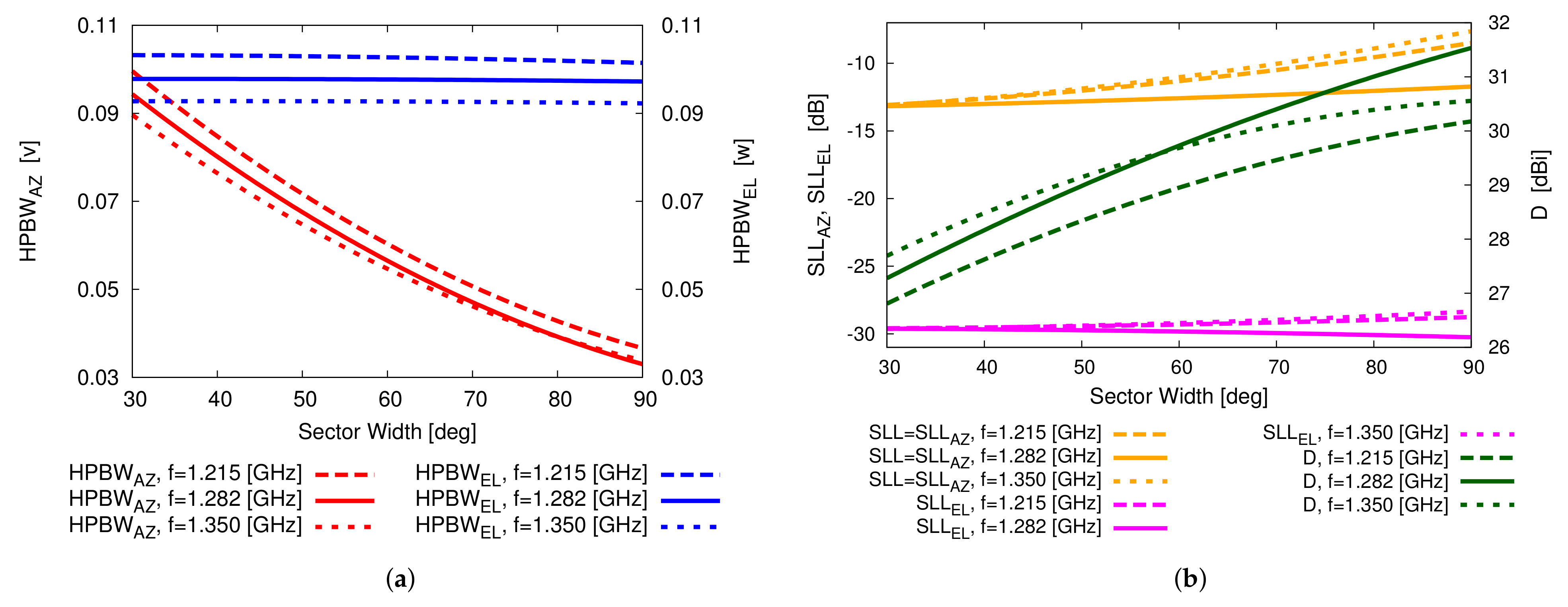1. Introduction
Surveillance systems are crucial elements in airports for the correct execution of all terminal functions and procedures such as airplanes take off and landing, air traffic management, and terminal security. Nowadays, most air traffic control (ATC) radars use ground stations, equipped with large reflectors and/or array antennas installed on mechanical rotating pedestals, to yield a
view for tracking the targets all around. Such a technology, in place since the 1970s [
1], is currently close to upgrade and novel solutions, based on cylindrical or multi-face planar phased arrays (PAs) [
2,
3,
4,
5], are currently investigated. Thanks to the rapid scan, the clutter suppression, the multi-beam generation, and the multi-function capabilities (e.g., joint ATC and weather radar functionalities [
6,
7,
8]), electronically scanning PA-based solutions with DBF seem to be promising candidates for the next generation of ATC radar systems [
9,
10]. Indeed, compared to an analog beam-forming (ABF), the DBF has the advantage of simultaneously generating multiple beams on receive with arbitrary shapes. Moreover, DBF allows a very accurate pointing over wide bandwidths by avoiding the beam squint effects thanks to the use of true time delays [
11].
ATC radars require narrow beams to achieve high resolution and, consequently, they need PAs with large apertures and a huge number of radiating elements as well as analog-digital converters (ADCs). Although the cost, the size, and the power consumption of ADCs are continuously decreasing, the use of PAs with classical/fully-populated (FP) architectures (i.e., array layouts with uniformly-spaced radiating elements, each one equipped with a dedicated ADC) would result too expensive for commercial applications. Therefore, scalable and modular DBF implementations are of great interest for future fully-digital ATC PA-based radars. In this framework, innovative unconventional array architectures have been recently proposed to implement better cost-performance trade-off solutions [
12]. For instance, clustered/sub-arrayed PAs have been considered for reducing the number of control points by gathering multiple elements over a single input-output port to minimize the production and maintenance costs [
13,
14,
15,
16,
17,
18,
19,
20]. The main issue when resorting to clustered arrays is the unavoidable presence of undesired secondary lobes (i.e., the
quantization lobes [
21,
22]). To cope with this drawback, irregular arrangements of the array clusters have been exploited and the optimization of the sub-array configurations (i.e., sub-array position/size/shapes and excitations) has been carried out by means of various strategies [
13,
14,
15,
16,
17,
18,
19,
20].
Alternatively, another effective approach to simplify the PA architecture is array sparsening [
23,
24,
25,
26,
27,
28,
29,
30,
31,
32,
33]. By jointly optimizing the inter-element distances between the array elements and the corresponding excitation weights, the number of array elements is minimized, while fitting user-defined radiation performance. Deterministic [
24,
32] and stochastic techniques [
23,
25] as well as Compressive Sensing (CS) based methods [
26,
27,
28,
29,
30,
31,
33,
34] have been published in the recent scientific literature to synthesize sparse arrays.
This paper presents a DBF PA antenna for ATC radar systems, which has been preliminary introduced [
35], that benefits from both the modularity and the sparseness of the array layout. More specifically, the array is composed by sparse vertical planks (i.e., sub-array modules), to minimize the number of antenna elements and of the corresponding ADCs, positioned side-by-side over a truncated conical surface. The choice of a conical frustum shape is quite natural since the surface is already tilted towards the sky, thus a lower elevation scanning is needed [
36,
37,
38], while the DBF simultaneously generates multiple beams to cover the required elevation range. Thanks to the modular architecture along the vertical direction and the circular symmetry, the array affords a
view along the azimuth plane. Moreover, the processing of the signals collected by a contiguous subset of the array planks guarantees uniform radar performance [
39].
To determine the linear sparse arrangement of the elementary radiators of the vertical plank and the corresponding excitation sets, the synthesis problem is cast as an optimization one aimed at simultaneously generating multiple beams, as close as possible to those radiated by an ideal/reference FP faithfully fulfilling the user requirements, while jointly minimizing the number of elements. Towards this end, a sparse-regularization technique based on the Bayesian CS (BCS) technique is here exploited because of its proved efficiency and effectiveness in finding the sparsest linear [
26,
27], planar [
30] and conformal [
31] array layouts and the complex beam-forming weights that minimize the pattern matching misfit. However, none of the previous BCS synthesis methods [
27,
30,
31] has dealt with the joint generation of multiple simultaneous radiation patterns from a common sparse array layout. Therefore, this work introduces a novel synthesis strategy based on a Multi-Task (MT) [
40] implementation of the BCS where the condition of common positions for the array elements is enforced, while optimizing an independent set of complex (amplitude and phase) excitations for simultaneously generating multiple independent beams. The arising non-convex synthesis problem, not solvable by running a set (i.e., one for each beam) of parallel BCS-based optimizations because of the need to enforce a common array layout, is addressed by minimizing the
a-posteriori probability for the array to jointly match the target patterns by means of a fast Relevance Vector Machine (RVM) solver [
40]. The BCS has demonstrated requiring a computation burden several orders in magnitude lower than global optimization methods as well as the capability of easily including user-defined constraints on the array layout, not admissible with analytic techniques [
34].
To the best of the authors knowledge, the main novelties of this work with respect to the state-of-the-art literature include (i) the introduction of an innovative modular architecture (i.e., a conformal/conical multi-beam sparse receiving array) for ATC radar systems; (ii) the theoretical formulation of the design problem within the CS framework to yield a solution that assures the best compromise/trade-off between the closeness/fulfilment of the user/operative radiation requirements and the reduction of the architectural complexity (i.e., the minimum number of elements/ADCs); (iii) the development of a synthesis tool based on a customized implementation of the BCS to jointly synthesize the array layout and the sets of complex excitations for generating the multiple beams.
The rest of the paper is organized as follows. The synthesis of conical frustum fully-digital arrays for ATC radars is mathematically formulated in
Section 2, where the proposed MT-BCS based solution method is described, as well.
Section 3 presents a set of selected numerical results to validate the synthesis method and to assess the effectiveness of the arising layouts also considering realistic antenna models. Eventually, conclusions follow (
Section 4).
2. Mathematical Formulation
Let us consider a conical-frustum phased array (CPA) of
P radiating elements located on the surface of a truncated cone with axis along the
z Cartesian coordinate and circular bases lying on the (
x,
y)-plane with radii
R (major base radius) and
r (minor base radius), respectively (
Figure 1). Such a CPA is composed by
N vertical planks of
M elements (
) placed side-by-side at a constant distance
measured along the circular perimeter of the minor base of the cone. To yield a modular CPA architecture, all
N planks are equal and they consist of a sparse linear distribution of the elementary radiators over a regular lattice,
(
) being the inter-element distance between the
mth and
th adjacent elements, while
l (
) is the length of the plank [i.e., the distance between the first (i.e.,
) and the last (i.e.,
) elements along the plank axis]. Thus,
and
,
being the cone slant angle (
Figure 1 and
Figure 2), while the coordinates of the position of the
mth (
) element in the
nth (
) array-column/plank turn out to be shown in Equation (
1)
where
(
) is the angular distance between the centers of two planks (
Figure 1) and
(
) is the distance between the first element and the
mth one, being
and
.
The generation of
B pencil beams (
Figure 2) pointing along different elevation directions, {
;
}, is obtained by controlling the amplitude and the phase weights of the CPA excitations by means of the fully DBF architecture sketched in
Figure 3. More in detail, the signal received by each antenna is digitized with an ADC and it is weighted by the set of amplitude weights,
(
≜ {
;
;
;
}), and phase delays,
(
≜ {
;
;
;
}), that are combined to afford the
B independent patterns, each
bth (
) beam pointing towards the user-defined angular direction
. The electromagnetic far-field pattern of the
bth beam (
) radiated by the CPA is shown in Equation (
2)
where
is the embedded/active
-element pattern [
21,
22],
is the steering vector, and
is the complex excitation weight of the
th (
;
) radiator,
being the free-space wavelength at the working frequency
. The array factor corresponding to the
bth beam (
), independent of the type of radiators used in the practical array, is given by
.
Because of the modularity of the CPA at hand and that pointing the mainlobe towards the
bth (
) direction,
, means analytically adding to the
th (
;
) digital phase coefficient,
, a shift value, as shown in Equation (
4)
the degrees of freedom (DoFs) in designing such a CPA architecture turn out to be only those of a single plank, namely the positions of the
M-element sparse linear array of the plank and the corresponding amplitude,
(
), and phase,
(
), excitation coefficients, being
and
(
;
). The design of the CPA is then cast as the synthesis of the linear sparse array, which composes the vertical plank, that simultaneously generates
B beams. Mathematically, it can be stated as follows:
Multi-Beam Sparse Array Synthesis Problem (MBSASP)—Given a set of
B reference beam patterns, {
;
}, radiated by a reference FP linear array of
I elements uniformly spaced by
d and pointing towards
B directions along the elevation plane (
Figure 2), {
;
}, determine the corresponding
M-element (
) maximally sparse arrangement and the set of
B amplitude
and phase
excitation coefficients (
), such that
M is minimum and the multi-beam pattern matching constraint
is satisfied, {; } being the set of K sampling directions along the elevation plane, while is the user-defined parameter controlling the degree of accuracy of the patterns matching.
To solve the MBSASP, let us consider a coordinate system with the
-axis along the plank column (
Figure 1 and
Figure 2) so that the corresponding broadside direction,
, coincides with the slant angle
of the reference coordinate system (
Figure 2), being
, and the non-uniform positions of the
M elements of the plank, {
;
}, belong to a set of
Q (
) user-defined candidate locations, {
;
}, of a uniform lattice [see for instance
Figure 4a). Accordingly, the synthesis of the
B sets of complex excitation weights
≜ {
;
;
},
being the Kronecker function (
if
and
, otherwise), is mathematically formulated as Equation (
6)
subject to Equation (
7)
where
is the steering matrix (
),
(
) is the set of
K samples of the
bth (
) reference pattern, while
is the
bth (
) noise vector whose entries are zero-mean Gaussian complex error values with variance
proportional to
.
The MT-BCS strategy [
27] is then adopted and customized to deal with the ill-posed/ill-conditioned problem in Equation (
6) by statistically correlating the
B sets of array excitations. This implies to enforce the linear array having non-null excitations at the same positions of the
Q-locations uniform lattice so that the sparsest array layout (i.e., the minimum value of
M) is retrieved. More specifically, each
bth (
) constraint in Equation (
7) is coded into 2 real-valued tasks as shown in Equation (
8) (The problem constraints are transformed in a real-valued form to enable the use of
CS-based state-of-the-art algorithms [
34].)
where
and
,
and
being the real part and the imaginary one, respectively,
and
are two real-valued vectors such that
. Moreover,
and
are also real-valued vectors such that
, and
is a
real-valued matrix.
The sparsest weights vectors
and
(
) are then derived by maximizing, component-by-component, the
a-posteriori probability of having the
coefficients in correspondence with the set of reference pattern samples
It turns out to Equation (
10) [
27]
where
is the shared hyper-parameter vector determined with the RVM solver [
40].
Finally, the
bth (
) set of complex excitations affording the desired
bth beam is obtained as shown in Equation (
11)
Unlike phase-only multiple beam synthesis approaches, the possibility to exploit both the excitation amplitudes and phases allows more effective pattern matching, and consequently pattern shaping, performance.
3. Numerical Validation
This section has a twofold objective. On the one hand, to assess the effectiveness of a sparse CPA architecture for ATC applications, on the other, the validation of the proposed BCS-based multi-beam synthesis method.
In the benchmark scenario, the CPA has been required to generate
beams pointing at different elevation angles such that each beam intersects at
dB the left and the right neighboring beams (
Figure 5b) to ensure a
dB power coverage within an angular range of
(
Figure 2). To span the elevation range
, the slant angle has been set to
[
36,
38], the horizon being at
. Therefore, the
B steering angles in the plank coordinate system, {
;
}, have been set as in
Table 1, where the corresponding
and
power pattern intersection points at
dB and the half power beamwidth (HPBW) are reported, as well.
As a starting point for the MT-BCS synthesis of the single plank, ideal radiators (i.e.,
,
,
,
being the element pattern of the isotropic antenna) are taken into account. Moreover, the linear configuration of
uniformly-spaced (
⇒
) elements in
Figure 5a has been used as reference, while the power patterns (
Figure 5b) radiated by the corresponding (reference) FP-CPA, composed by
columns spaced by
for a total of
elements, have been synthesized by tapering the array excitations with a Taylor distribution [
41] having
dB and
. These choices resulted in a cone geometry with minor (major) radius equal to
(
). Successively, multiple runs of the MT-BCS code have been performed by varying the lattice (i.e., the number of
Q partitions of
l:
) and the reference pattern sampling (i.e.,
K:
) as well as the MT-BCS control parameters according to the guidelines in [
27,
28,
29,
30,
31] (i.e.,
,
, and
,
and
being the MT hyper-priors [
30]) to explore the achievable trade-offs between pattern matching performance and array sparseness. The degree of optimality of the synthesized layouts has been quantified with the multi-beam power pattern matching error,
, defined as
being
the single
bth (
) beam error. The arising Pareto front of the solutions in the
plane is shown in
Figure 6. As it can be observed, the error drops down the value of
with at least
elements (
,
,
,
, and
). In this latter case, the array layout is characterized by an aperture of length
and a maximum (minimum) inter-element spacing equal to
(
) (
Figure 4a). The shapes of the
radiated beam patterns are compared to the reference ones in
Figure 4b to give an insight on the pattern matching accuracy. For completeness, the
B sets of the optimized complex excitations, {
;
}, are shown in
Figure 4c, while the values of the matching error for each
bth (
) beam,
, are given in
Table 2 together with the main pattern descriptors [i.e., the side lobe level (SLL), the peak directivity (D), and the HPBW]. It is worth noticing that the MT-BCS design faithfully matches the whole set of reference patterns (e.g., the maximum degradations of the SLL, of D, and of HPBW being
dB,
dBi, and
, respectively) despite a reduction of
% of the elements of the FP array. For illustrative purposes, the inset of
Figure 4b shows the case with the worst matching error in
Table 2 (i.e.,
).
In order to assess the reliability of the proposed sparse plank architecture and its robustness against the non-idealities of real arrays, a square-ring microstrip antenna (
Figure 7a), suitable for wide angle scanning [
42] and resonating in the L-band, has been chosen as elementary radiator of the array. To include the mutual coupling effects of the real array structure, the whole plank model shown in
Figure 7b has been simulated at
GHz using the finite-element full-wave solver of Ansys HFSS [
43]. The comparison of the
B power patterns radiated by the ideal and real plank model is shown in
Figure 8. As it can be observed, apart from the different power level (
Figure 8a), the real and the ideal normalized curves overlap in the main beam region, while some differences appear in the far sidelobe region (
Figure 8b).
Once the sparse plank has been synthesized, the CPA has been assembled by subdividing the lateral surface of the cone into
S vertical sectors, each composed by
contiguous planks. The
planks, belonging to the
sth (
) vertical sector, are responsible of generating
B beams pointing towards the desired
B directions along the elevation plane, {
;
}, while having the same azimuth angle [i.e.,
(
)—
Figure 9a–c).To assess the performance of the 3D conical-frustum array in focusing the beam along elevation and azimuth, different CPA configurations have been taken into account by setting the angular width of the vertical sector to
(
Figure 9a),
(
Figure 9b), and
(
Figure 9c), which means an architecture of
sectors with
planks (
Figure 9a,g),
sectors with
planks (
Figure 9b,h), and
sectors with
planks (
Figure 9c,i), respectively.
Figure 10 shows in a color-map representation the power patterns in the
-plane (
,
, being
and
) of a subset (i.e.,
) of the
beams radiated by the
sector CPA. The plots refer to three different frequencies within the L-Band, which is a typical frequency range reserved for aeronautical radio-navigation/radio-localization and, in particular, for Primary Surveillance Radar (PRS) applications [
1]. More specifically, the frequencies
GHz (
Figure 10a–d),
GHz (
Figure 10e–h), and
GHz (
Figure 10i–l) have been analyzed and the performance of the sparse CPAs (
Figure 9g–i) with respect to the reference FP ones (
Figure 9d–f) have been evaluated still with the pattern matching metric in Equation (
12), but now considering the two angular variables
(i.e.,
). The behavior of
versus the beam number (
) at the selected frequencies can be inferred by the plots in first line of
Figure 11, which refer to the
(
Figure 11a), the
(
Figure 11c), the
(
Figure 11e) sectorized CPA, respectively. Generally, the error values are in the order of
and slightly increase (
) only for the border beams (i.e.,
and
) at the higher frequency (i.e.,
GHz). To give the interested readers some insights on the distribution of the error done in approximating the reference pattern within the (
v,
w)-plane, a local mismatch index,
, has been defined as
and it has been computed for the worst cases having the greater values of
(i.e.,
@
GHz) (
Figure 11—second line]. As it can be inferred, the most significant deviations from the reference pattern turn out to be close to the
[→
] angular direction, that is, far away from the main-beam in the low sidelobe region (
Figure 10i).
Next, the main pattern descriptors (i.e., the HPBW along the azimuth (
) and elevation (
), the SLL, the SLL in the elevation plane (
), and the peak directivity D) of the different sparse CPA configurations have been analyzed. As a representative example of the whole set of results, the discussion will be focused on the central beam (i.e.,
).
Figure 12a shows the behaviors of
and
versus the sector width
of the CPA architecture. As expected, there is an unavoidably beam broadening effect when increasing the operation frequency and the
reduces of almost one third widening the angular width of the vertical sector from
up to
. Concerning the values of SLL and D, which are reported in
Figure 12b, it turns out that D increases with the sector width due to the larger size of the aperture that radiates the beam, but the same holds true for the SLL due to the high sidelobes in the azimuth plane since the CPA sector behaves as a uniform array along such a plane (i.e., all planks as well as the element excitations are equal and without tapering along the azimuth plane). However, the azimuth-plane sidelobes can be easily lowered by exploiting, for instance, the pattern multiplication strategy [
21,
22]. Accordingly, a Taylor taper [
41] with
dB and
has been applied to the amplitudes of the
planks of the sparse CPA assembled with
vertical sectors. As expected, the plots of the power patterns radiated at the central frequency
for the
beams in
Figure 13 do not present the high sidelobes along the azimuth plane of the corresponding ones in
Figure 10e–h. Indeed, the SLL now turns out to be
dB, which is a value very close to the reference Taylor one.
Finally, the behavior of the real model of the proposed sparse CPA modular architecture has been assessed. Towards this end and in order to enable the HFSS full-wave simulation, the far-field patterns of the
B beams have been computed as
(
), where the embedded element pattern
, assumed equal for all antennas (i.e.,
,
,
), has been set to the one of the central element of a neighborhood of
identical square-ring microstrip antennas (
Figure 7a) conformal to the CPA support (
Figure 14a). For illustrative purposes, the 3D plots of the embedded pattern at the frequencies of interest are reported:
GHz (
Figure 14b),
GHz (
Figure 14c), and
GHz (
Figure 14d). To analyze the radiation performance,
Figure 15 compares, along the elevation plane, the power patterns radiated at
GHz by the real and the ideal (i.e.,
) sparse CPAs in the
(
Figure 15a,d),
(
Figure 15b,e), and
(
Figure 15c,f) configurations. Also in this case, the shapes of the real and the ideal curves show only negligible deviations in the far sidelobe region while the mainlobes are substantially identical (
Figure 15d–f).

